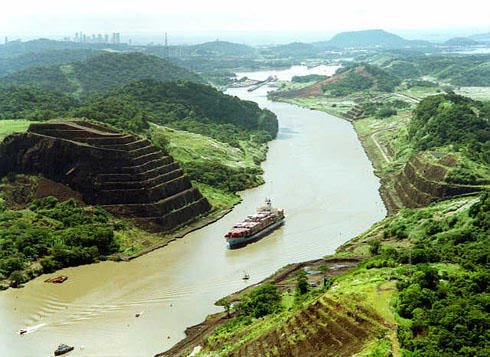Panama Canal

Tuesday, May 22, 2012
PP Notes Korea
Chosun Dynasty 1392-1910 CE
Chosun’s Beginnings:
Yi Seung-kye is dispatched to repel Ming attack
Concludes he can’t win
Negotiates with invaders
Returns to Kaesung and takes over city with Ming help
Ming alliance
New Chosun Dynasty
Named by Ming Emperor
朝鮮 -- 조선 – “Morning Calm”
Ming China invades Korea 1392
Yi’s diagnosis of Koryo’s failings:
Buddhism – too influential
Confucianism is the answer
Focus on Confucian relationships and virtues
Five Relationships
Hyo (filial piety) is the core virtue
Neo-Confucian orthodoxy
Chosun and Gender
Patrilocal marriage
Rigid patriarchy
Women’s roles
Strict obedience
Produce a son
Woman’s Three Lords:
Father … Husband … Son
Strict Chastity
Chosun women’s small dagger
Religious intolerance
Buddhism
Persecuted
Driven out of cities
Lands confiscated – hence: Mountain Temples
Becomes a religion predominantly of women
Chosun Dynasty
Censorate system
Confucian Secret Investigator
Focus on Scholarship:
Sungkyunkwan University 1400s
Focused on Confucian Scholarship
Now a major, modern university
King Sejong: 1418-1450
Patron of Arts and Sciences
Printing of Confucian classics
Moveable type used heavily
Hangul
Commissioned Korea’s Phonetic Script
His most famous accomplishment
Hideyoshi Invasion: 1592
Korea occupied, ransacked
National treasures destroyed
Tremendous animosity developed
Non’gae -- “Patriotic Kisaeng”
Turtle ships
Korea Liberated
Reemphasize Confucianism: Korea is the last bastion of civilization…
Korea as the Hermit Kingdom
Catholics Enter Korea: 1784
Two Korean Yangban Discover Catholicism in China
Convert
Bring back Catholic books
Teach Catholicism in Korea
French priests sneak in
Chesa condemned as “worship”
Catholicism not warmly welcomed by government
Catholics In Korea
Silk letter 1801
Smuggled with tribute mission
to China
Discovered
Requested French intervention to ensure Catholic rights in Korea
Chesa Controversy
Catholics forbidden to perform Chesa
Government declares Catholicism illegal
Catholic Pogroms: 1860s
Thousands beheaded
French Respond with brief naval attack
Catholics In Korea
Catholics (mostly Yangban) retreat from public life
Live in small villages
Make ceramic pots
Kimchi Pots
“Potter” is slang for
Catholic
Korea and the West
General Sherman incident 1866
American Merchant Marine Ship
Sunk and burned
1871 retaliation for General Sherman
US sends retaliatory naval strike
Pressure from Japan
1874: first unequal treaty – Japan
Grants Japan special rights in Korea
Japan may intervene if other nations do
Koreans recognize the threat, but are powerless to resist
Korea and the West
1882: first US Treaty
“Good offices” clause
Korea sees it as mutual defense
Protection from the real threat: Japan
West, esp. US, seen as potential savior from the more-threatening Japanese
Korea and the West Protestants
1884 Dr. Horace Allen
MD to the US Consulate
Presbyterian Missionary
Heals Korean Crown Prince
Granted one favor
Requests freedom of religion for Korea and missionary rights for Christianity
Protestants in Korea
Enter 1884
Adopt Nevius Method
Service: education, medical care, etc
Focus on poor and women
Cultivate local clergy and leadership ASAP
Prepare for local church independence
Protestants in Korea
Bible (성경)
is the first major
work published in
hangul (한글) – not Chinese
Prompts the beginning of Hangul literature movement
Protestants in Korea
Presbyterian Structure
Governance by “Elders”
Lay leaders play major role: High prestige
Democratic, participatory structure
Koreans flock to Presbyterians
Christians seen as connected with America
America seen as the one hope for protection from Japan
Western Education (in Christian Schools) seen as the key to modernizing the nation
Non-Christian Korean nationalists flock to Christian schools for modern, Western education
Protestants in Korea
Provide Best education available
Become core to nationalist and
modernization movements
Grow and develop rapidly
Develop a strong national network of hundreds of churches and many thousands of members by 1900
Late Chosun Government: Decay and Stagnation
Government stagnates and tries to avoid reform or Western interaction as much as possible
Dominated by Conservative Queen Min
Queen Min, like China’s Empress Dowager, was a tyrannical traditionalist
Kabo Reforms: Attempt to modernize after Queen Min’s death
Modernization effort, but too little, too late
Tonghak Rebellion
Tonghak Rebellion: 1894 (Eastern Learning)
Nativist movement growing out of the Chundokyo Religion (a native Korean religion borrowing both from Daoism and Christianity)
Deeply Anti foreign
Chosun Government could not repress the Tonghaks
Calls in China and Japan asserts 1874 treaty to follow
Sino-Japanese War 1894-95
Chosun Collapse
Chosun Weakened
King even seeks protection
in Russian Embassy
Russo-Japanese War 1904-05
Russia forced to leave
Korea becomes a Japanese protectorate
Meaning Japan “protects” (dominates) Korea
Japanese Occupation 1910-1945
Koreans continue to look to US as potential savior
Look to Protestant churches as special connection to America
Japan annexes Korea 1910
Taft-Katsura Agreement
US concurs secretly that Japan should lead to modernize and develop Korea
Protestant Missionaries agree:
Japan is the one modern Asian Nation
Korean’s need Japanese tutelage
Koreans today see this as a major betrayal
Subscribe to:
Post Comments (Atom)
No comments:
Post a Comment